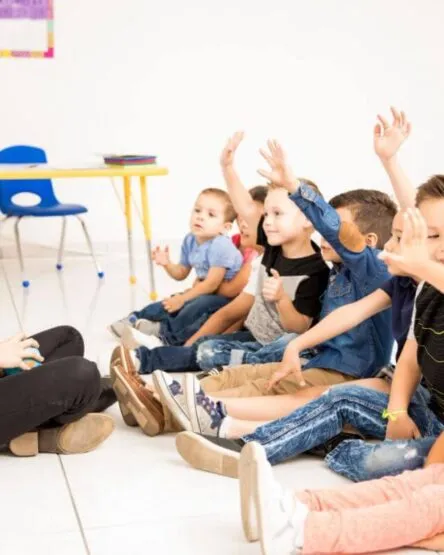What are the ways school helps kindergarteners strengthen their attention spans?
- Establishing consistent routines
- Incorporating movement and physical activities
- Using interactive and hands-on learning
- Creating a focus-friendly environment
- Encouraging self-regulation and independence
Overview
- This article explores how schools support the development of children’s attention spans.
- It highlights strategies like establishing consistent routines, incorporating physical activities, using hands-on learning, creating focus-friendly environments, and encouraging self-regulation.
- These approaches help children improve concentration, manage distractions, and build essential cognitive skills for academic success.
A child’s ability to maintain focus is shaped by various factors, including age, developmental stage, environment, and overall well-being. Challenges such as distractions, fatigue, hunger, or certain neurodevelopmental conditions may affect their concentration. On the other hand, supportive environments and engaging, well-structured activities can help strengthen their attention span.
Schools significantly contribute to the development of children’s attention spans by strategically balancing stimulation and support. Through well-designed tasks and consistent routines, teachers help students stay attentive and develop essential cognitive skills.
In this article, we’ll explore ways school helps kindergarteners strengthen their attention spans, focusing on how classroom activities and teacher strategies nurture these essential skills.
Establishing Consistent Routines
Consistent daily routines provide children with predictability, which reduces anxiety and consequently enhances their ability to focus. This structured schedule enables children to better manage their time and allocate their attention effectively across various tasks throughout the day.
Having regular routines creates a stable environment where children know what comes next. This predictability helps them feel secure, allowing them to concentrate better.
At Reedley Kindergarten School, we encourage routines to provide young learners with the structure they need. We understand how essential it is for children to develop a sense of time and smooth transitions between activities, helping them focus and complete tasks efficiently.
Incorporating Movement and Physical Activities
Regular breaks for physical activity are essential in helping children reset their focus. Simple activities like stretching, jumping jacks, or outdoor play provide opportunities for children to release pent-up energy, making it easier for them to concentrate when they return to tasks.
Physical activity also enhances student engagement levels. When children are given time to move, they are more likely to participate actively in lessons, which in turn helps them maintain focus. Short bursts of movement, such as stretching or brief walks, not only re-energize students but also prepare them mentally for the tasks ahead.
Additionally, movement-based learning activities—like interactive games or hands-on experiments—bring variety to the classroom, keeping students interested and engaged. This diversity in activities prevents monotony, which can lead to a loss of focus. By integrating movement with learning, we create a dynamic environment that fosters better attention spans and a more enjoyable learning experience.
Using Interactive and Hands-On Learning
In the classroom, interactive and hands-on activities—like puzzles, memory games, and arts and crafts—serve more than just fun. They help children develop essential focus skills while keeping them engaged in the learning process. These activities encourage active participation, which is key to improving attention spans.
When children are involved in hands-on learning, they naturally stay more engaged. Active participation helps them maintain focus longer than traditional, passive methods like listening to lectures or watching videos. The hands-on approach encourages children to stay on task, which strengthens their attention over time.
Additionally, experiential learning allows children to connect with concepts on a deeper level. By physically interacting with the material—whether through hands-on experiments or exploring objects—they’re able to better retain information, leading to sustained attention in future tasks.
Creating a Focus-Friendly Environment
A well-organized classroom minimizes distractions, helping children concentrate better on their tasks. A structured environment supports academic growth by providing the necessary framework for mastering new skills and concepts. This structure fosters attention span development, allowing children to focus on learning activities.
Reducing visual and auditory distractions helps children stay engaged. Organized workspaces with minimal clutter allow them to focus on tasks without unnecessary interruptions. When children aren’t distracted by their surroundings, they can direct their attention to what matters most.
A focus-friendly environment provides a safe and nurturing space where children can confidently explore and learn. This security encourages greater participation in activities, further enhancing their ability to concentrate and retain information.
Encouraging Self-Regulation and Independence
Schools and teachers play a key role in teaching children about attention and self-regulation, helping them recognize when they are losing focus and how to refocus their attention. This could include using tools like timers or signals to remind them to stay engaged.
Self-regulation, which involves managing emotions, impulses, and behaviors, is important for staying focused on tasks. As children learn this skill, they can better direct their attention and resist distractions.
Encouraging independence also helps by allowing children to make choices about their activities, giving them a sense of control over their learning. When children feel empowered, they’re more likely to engage with tasks and stay focused. Completing tasks on their own builds confidence and motivation, making them more willing to take on new challenges. For example, finishing a puzzle independently can help children feel proud and ready for more.
Key Takeaway
There are many ways school helps kindergarteners develop attention spans, and by understanding these strategies, you can better support your child’s focus and cognitive growth. Ensuring that your learner benefits from structured routines, engaging activities, and a supportive classroom environment will lay the foundation for their future learning success.
Set your kindergartener up for a bright future at Reedley Kindergarten School. We provide a nurturing and stimulating environment that fosters a love for learning and builds a strong foundation for academic success. Contact us today to learn more about our programs and give your child the best start.
